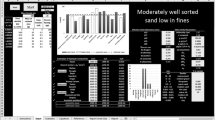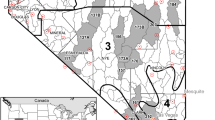Abstract
HydrogeoEstimatorXL is a free software tool for the interpretation of flow systems based on spatial hydrogeological field data from multi-well networks. It runs on the familiar Excel spreadsheet platform. The program accepts well location coordinates and hydraulic head data, and returns an analysis of the area flow system in two dimensions based on (1) a single best fit plane of the potentiometric surface and (2) three-point estimators, i.e., well triplets assumed to bound planar sections of the potentiometric surface. The software produces graphical outputs including histograms of hydraulic gradient magnitude and direction, groundwater velocity (based on a site average hydraulic properties), as well as mapped renditions of the estimator triangles and the velocity vectors associated with them. Within the software, a transect can be defined and the mass discharge of a groundwater contaminant crossing the transect can be estimated. This kind of analysis is helpful in gaining an overview of a site’s hydrogeology, for problem definition, and as a review tool to check the reasonableness of other independent calculations.
Résumé
HydrogeoEstimatorXL est un logiciel libre d’accès pour l’interprétation des systèmes d’écoulement basés sur des données hydrogéologiques spatiales de terrain provenant de réseaux de multiples puits. Il fonctionne sur l’environnement familier du tableur Excel. Le programme accepte les coordonnées de la localisation des puits et les données des charges hydrauliques, et renvoie à une analyse du système de l’aire d’écoulement en deux dimensions selon (1) un seul plan d’ajustement de la surface piézométrique et (2) des estimateurs à trois points, c’est-à-dire triplets de points supposés relier des sections planes de la surface piézométrique. Le logiciel produit des sorties graphiques comprenant des histogrammes de l’amplitude et de la direction du gradient hydraulique, de la vitesse d’écoulement des eaux souterraines (basée sur les propriétés hydrauliques moyennes du site), ainsi que des rendus cartographiques des triangles de l’estimateur et des vecteurs de vitesse qui leurs sont associés. A l’aide de ce logiciel, une section transversale peut être définie et la décharge massique de contaminants des eaux souterraines recoupant cette section peut être estimée. Ce type d’analyse est utile pour obtenir une vue générale de l’hydrogéologie d’un site, pour la définition du problème et comme outil d’évaluation pour vérifier le caractère raisonnable d’autres calculs indépendants.
Resumen
HydrogeoEstimatorXL es una herramienta de software libre para la interpretación de sistemas de flujo basados en datos hidrogeológicos espaciales de campo a partir de redes de pozos múltiples. Se ejecuta en la conocida plataforma de hoja de cálculo de Excel. El programa acepta las coordenadas de ubicación del pozo y los datos de la carga hidráulica, y devuelve un análisis del sistema de flujo del área en dos dimensiones basado en (1) un mejor plano de ajuste de la superficie potenciométrica y (2) estimador de tres puntos, por ejemplo, se asume que el terceto de pozos se unen a secciones planas de la superficie potenciométrica. El software produce salidas gráficas incluyendo histogramas de magnitud y dirección del gradiente hidráulico, velocidad del agua subterránea (basada en las propiedades hidráulicas promedio de un sitio), así como representaciones mapeadas de los triángulos estimadores y los vectores de velocidad asociados con ellos. Dentro del software, se puede definir un corte transversal y se puede estimar la descarga de la masa de un contaminante de agua subterránea que cruza dicho corte. Este tipo de análisis es útil para obtener una visión general de la hidrogeología de un sitio, para la definición del problema y como una herramienta de revisión para comprobar la razonabilidad de otros cálculos independientes.
摘要
水文地质估算者XL是一款免费软件工具,这款工具根据多井网络的空间水文地质野外数据解译水流系统。它在人们所熟悉的Excel电子表格**台上运行。程序接受井的位置坐标及水头数据,并且基于(1)单个等势面最佳匹配面及(2)三点估计量,即假定限定等势面的**面部分的三井返回进行二维分析该区域的水流系统。软件得到图形输出,包括水力坡度幅度和方向的柱状图、地下水速度(基于现场**均水力特性)以及绘出的估计量三角形结果和与其相关的速度矢量。在软件内,可以定义横断面,可以估算穿过横断面的地下水污染物的大量排泄。这种分析对于问题定义、获取现场水文地质的概况非常有用,作为一个检阅工具来检查其他独立计算结果的合理性也是非常有用。
Resumo
HydrogeoEstimatorXL é um software livre para interpretação de sistemas de fluxo baseado em dados hidrogeológicos espaciais de campo de redes multipoços. Ele opera na plataforma familiar de planilha Excel. O programa aceita as coordenadas de localização dos poços e dados de carga hidráulica, e retorna uma análise do sistema de fluxo da área em duas dimensões baseado em (1)plano de melhor ajuste único da superfície potenciométrica e (2)estimadores de três pontos, p. ex., supondo que tripletas de poços amarrem as sessões planares da superfície potenciométrica. O software produz saídas gráficas incluindo histogramas da magnitude e direção do gradiente hidráulico, velocidade das águas subterrâneas (baseada nas propriedades hidráulicas médias locais), como também interpretações mapeadas dos triangulos de estimação e os vetores de velocidade associados a eles. No software, pode-se definir um transceto e estimar a massa de águas subterrâneas contaminada descarregada cruzando o tranceto. esse tipo de análise é útil em obter uma visão geral de uma situação hidrogeológica, para definição de problema, e como uma ferramenta de revisão para checar a razoabilidade de outros cálculos independentes.





Similar content being viewed by others
References
Abriola LM, Pinder GF (1982) Calculation of velocity in three space dimensions from hydraulic head measurements. Ground Water 20(2):205–213
Beyer WH (1973) CRC standard mathematical tables, 25th edn. CRC, Boca Raton
Bil** M, Ross RR, Acree SD (2014) 3PE: a tool for estimating groundwater flow vectors. EPA 600/R-14/273, US EPA, Washington, DC. www.epa.gov/ada. Accessed September 2014
Butler JJ (1997) The design, performance, and analysis of slug tests. CRC, Boca Rotan, FL
Butler JJ Jr, Healey JM, McCall GW, Garnett EJ, Loheide SP (2002) Hydraulic tests with direct-push equipment. Ground Water 40(1):25–36
Butler JJ, Dietrich P, Wittig V, Christy T (2007) Characterizing hydraulic conductivity with the direct-push permeameter. Ground Water 45(4):409–419
Critchley K, Rudolph D, Devlin JF, Schillig PC (2014) Stimulating in situ denitrification in an aerobic, highly permeable municipal drinking water aquifer. J Contam Hydrol 171:66–80
Devlin JF (2003) A spreadsheet method of estimating best-fit hydraulic gradients using head data from multiple wells. Ground Water 41(3):316–320
Devlin JF (2015) HydrogeoSieveXL: an Excel-based tool to estimate hydraulic conductivity from grain-size analysis. Hydrogeol J 23:837–844
Devlin JF (2016) J.F. Devlin Homepage: Professor, Department of Geology, University of Kansas, Lawrence, KS. http://www.people.ku.edu/~jfdevlin/Software.html. Accessed December 2016
Devlin JF, McElwee CD (2007) Effects of measurement error on horizontal hydraulic gradient estimates. Ground Water 45(1):62–73
Fjordboge AS, Lange IV, Bjerg PL, Binning PJ, Riis C, Kjeldsen P (2012) ZVI-Clay remediation of a chlorinated solvent source zone, Skuldelev, Denmark: 2. groundwater contaminant mass discharge reduction. J Contam Hydrol 140–141:67–79
Freeze RA, Cherry JA (1979) Groundwater. Prentice Hall, Englewood Cliffs, NJ
Heath RC (1983) Basic ground-water hydrology. US Geol Surv Water Suppl Pap 2220
Kelly WE, Bogardi I (1989) Flow directions with a spreadsheet. Ground Water 27(2):245–247
Knight R (2001) Ground penetrating radar for environmental applications. Annu Rev Earth Planet Sci 29:229–255
Kruseman GP, de Ridder NA (1991) Analysis and evaluation of pum** test data, 2nd edn. International Institute for Land Reclamation and Improvement, Publication 47, Wageningen, The Netherlands
KU ScholarWorks (2016) HydrogeoEstimatorXL: an Excel-based tool for estimating hydraulic gradient magnitude and direction. http://hdl.handle.net/1808/22049. Accessed Nov 2016
Lange IV, Troldborg M, Santos MC, Binning PJ, Bjerg PL (2011) Kvantificering af forureningsflux i transekt ved Skuldelev. Datarapport et samargjdsprojekt mellem, DTU Miljø og Region Hovedstaden [Quantification of contaminant flux in transects at Skuldelev. Data Report of a joint project between DTU Environment and the Capital Region], Copenhagen, Denmark
Legchenko A, Baltassat JM, Beauce A, Bernard J (2002) Nuclear magnetic resonance as a geophysical tool for hydrogeologists. J Appl Geophys 50:21–46
McKenna SA, Wahi A (2006) Local hydraulic gradient estimator analysis of long-term monitoring networks. Ground Water 44(5):723–731
Molz FJ, Morin RH, Hess AE, Melville JG, Guven O (1989) The impeller meter for measuring aquifer permeability variations: evaluation and comparison with other tests. Water Resour Res 25(7):1677–1683
Pinder GF, Celia M, Gray WG (1981) Velocity calculation from randomly located hydraulic heads. Ground Water 19(3):262–264
Schillig PC, Devlin JF, Rudolph D (2016) Upscaling point velocity measurements to characterize a glacial outwash aquifer. Groundwater 54(3):394–405
Silliman SE, Frost C (1998) Monitoring hydraulic gradient using three-point estimator. J Environ Eng 124(6):517–523
Troldborg M, Nowak W, Lange IV, Santos MC, Binning PJ, Bjerg PL (2012) Application of Bayesian geostatistics for evaluation of mass discharge uncertainty at contaminated sites. Water Resour Res 48:W09535. doi:10.1029/2011WR011785
Zemansky G, Devlin JF (2013) Point velocity probe technology transfer. GNS Science Consultancy Report 2013/199, August, GNS, Lower Hutt, New Zealand
Acknowledgements
Gil Zemansky and Poul Bjerg are acknowledged for helpful comments in early drafts of this manuscript.
Author information
Authors and Affiliations
Corresponding author
Rights and permissions
About this article
Cite this article
Devlin, J.F., Schillig, P.C. HydrogeoEstimatorXL: an Excel-based tool for estimating hydraulic gradient magnitude and direction. Hydrogeol J 25, 867–875 (2017). https://doi.org/10.1007/s10040-016-1518-4
Received:
Accepted:
Published:
Issue Date:
DOI: https://doi.org/10.1007/s10040-016-1518-4




